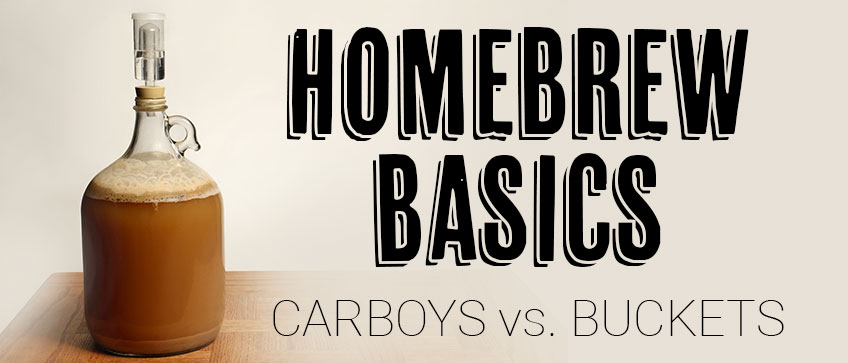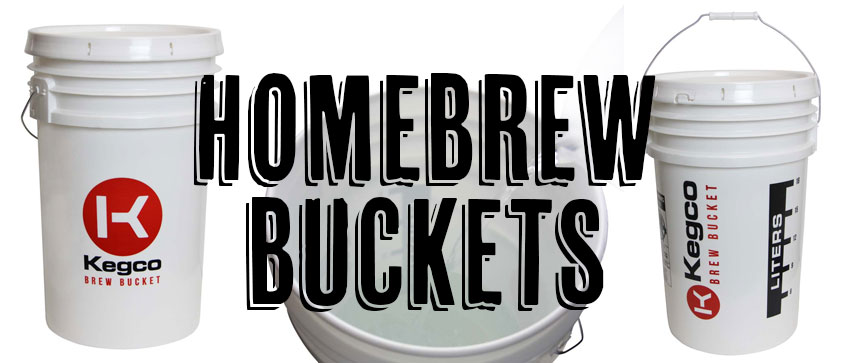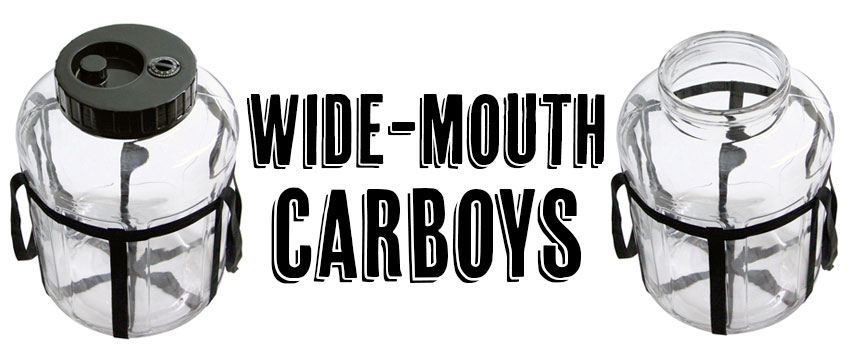May 19, 2020

When it comes to brewing beer, there are a variety of methods and techniques, they are viable methods for brewing and really comes down to your preferences and budget. Your fermenting vessel is essential to your resulting beer and it greatly affects your brewing techniques. As passionate beer brewers ourselves, we wanted to share with you the pros and cons of these vessels for fermenting.

Homebrew Buckets
Plastic Hombrewing Buckets are an affordable staple for beginning brewers to experiment with brewing. A standard sized bucket is 6.5 gallons and ideally, you want to get a bucket that has a lot of headspace at the top to accommodate for the krausen that often forms during fermentation. Our favorite is the Kegco 6.5 Gallon Brew Bucket, which is made of food-grade plastic and has graduation on the sides to easily measure the volume of liquid.
Pros
- Affordable - Buckets are the most affordable option and ideal for a first-time homebrewer. Brew buckets can be found virtually anywhere and they're inexpensive, which means if something goes wrong or the vessel gets contaminated, you can easily throw it out without feeling guilty. This is also great for those experimenting with new brews or sour beers, which are notorious for contaminating their vessels.
- Wide opening - The wide opening of the bucket makes it easy to pour and clean the vessel. When fermenting, a thick foam of yeast and wort proteins, which sticks to the top and sides of the fermenting vessel is known as krausen. With a lid that opens up completely, it is easy to clean this gunk out from the bucket and reuse it. Additionally, with the wide opening, it is easy to pour the liquid out without any resistance, add additional flavorings or dry hops, and take hydrometer samples.
- Lots of headspace - Buckets allow for a lot of room for the krausen to rise during the fermentation phase.
- Safer - Plastic buckets aren't likely to shatter or break, even if you drop them, making them a safer option to glass carboys.
- Easy to carry -Buckets come with a built-in handle, which makes it easy to carry, move, and transport the bucket.
Cons
- Scratches easily - Plastic buckets tend to scratch much easier than glass, which can contribute to contamination of your brew because remnants of yeast and bacteria can live in these scratches. These scratches make the buckets difficult to clean thoroughly, which means these leftover remnants can contaminate your other brews.
- They're opaque - Opaque plastic buckets make it difficult to monitor the fermentation of your beer. In order to check on the progress of your beer, you will have to open the lid, which disrupts the formation of krausen, resulting in a lower clarity of your beer and you have a chance of introducing outside contaminants to your brew.
- Plastic is permeable to oxygen - Since plastic is more easily permeated by oxygen, buckets are not ideal for long term fermenting. Oxygen exposure can cause the flavors to change and cause the beer to go stale.

Classic Carboys
A classic carboy ranges from 3 to 6.5 gallons and is made of thick glass. It often has a tapered opening which is smaller than the actual vessel. Carboys are a homebrewer's essential because they are an affordable means to ferment without splurging on professional-grade equipment. Our favorite carboy is the Kegco 6 Gallon Glass Carboy, which has an air-tight construction and can easily be reused time and time again.
Pros
- Doesn't easily scratch - The glass construction of a carboy doesn't easily scratch, which minimizes the chances of cross-contamination from one brew to another when reusing the carboy.
- Can be thoroughly cleaned - Glass carboys can be very thoroughly cleaned using more aggressive methods and tools, like brushes without damaging the vessel and causing scratches.
- Fermentation can be monitored - Since the entire vessel is made of clear glass, you can easily monitor the progress of your fermentation. So you can make adjustments or add hops or flavorings during the appropriate phases of your fermentation.
- Glass is impermeable to oxygen - Since glass is impermeable to oxygen, it prevents longer fermenting brews from oxidizing and changing in flavor.
- Reduces unnecessary headspace - The smaller shape and size of a carboy reduces the amount of unnecessary headspace, which can cause oxidization of the beer. Oxidization will greatly affect the taste and flavors of your beer.
- Glass is non-porous - Since glass is non-porous, it doesn't trap any aromas, flavors, or by-products from previous brews.
Cons
- Difficult to clean - The narrow neck and tapered style of the carboy makes it difficult to easily clean thoroughly. You will often need specialized equipment like a carboy brush or a jet bottle washer to get into the curves and nooks of the carboy.
- Heavy glass construction - The thick glass construction of the carboy is heavy and cumbersome to manipulate and handle for pouring and moving. Especially, with the slick and smooth texture of the carboy, you need to be careful when handling the glass container. You can also purchase carboy carrying scraps to assist you with moving the carboy.
- Higher cost - Carboys tend to be a little more expensive but they are much more sturdy and can be reused for much longer.
- Need to be kept in the dark - Due to the clear glass construction, during fermentation, the carboy needs to be stored in a dark place or covered to prevent the beer from being exposed to UV light, which can cause "skunking", which is an unfavorable skunk-like taste and aroma to the beer.

Wide-Mouth Carboys
The wide-mouth carboy gives you the best of both worlds, with the wide-mouth of a bucket but with the sturdy class construction of a classic carboy. This new style of a fermenting vessel is innovating and changing homebrewing by making the fermenting and cleaning process much easier.
Our personal favorite is the Kegco Wide Mouth Glass Carboy, which comes in 4.75 gallons, 5.5 gallons, and 7-gallon sizes. These wide-mouth carboys allow you to install your own airlock but also comes with a built-in airlock. There is an adjustable dial to set your brew date and carrying straps for ease of use.
Pros
- Doesn't easily scratch
- Can be thoroughly cleaned
- Glass is impermeable to oxygen
- Fermentation can be monitored
- Reduces unnecessary headspace
- Glass is non-porous
- Built-in airlock and brew date tracker - We're a huge fan of these wide-mouth carboys for their convenient upgrades to the classic carboy. The built-in airlock allows gas to escape from the container during fermentation. With the built-in date tracker, you won't forget the date you started and you won't have to create a waterproof label for your carboy.
- Can be EASILY cleaned - Unlike a classic carboy, the wide mouth of this carboy allows you to get your hands into the actual vessel and scrub the entire interior thoroughly. This carboy cleans easily like a bucket but it can withstand a more aggressive scrub without scratching or damaging the vessel.
- Easy to carry and maneuver - The durable included carrying straps allow you to easily maneuver the often slippery and heavy glass carboy. The straps securely hug the carboy making it easy to lift the carboy even with liquid inside but they easily slide off for cleaning.
Cons
- Heavy glass construction
- Higher cost
- Need to be kept in the dark
Cleaning Homebrew Buckets and Carboys
Learn more about how to clean and care for these different brewing vessels in our video here:
Have more questions about homebrewing and homebrew equipment? Call our product specialists at 800-710-9939.


 Single Faucet Kegerator Beer Dispensers
Single Faucet Kegerator Beer Dispensers Dual Faucet Two Tap Kegerators
Dual Faucet Two Tap Kegerators Triple Faucet Three Tap Kegerators
Triple Faucet Three Tap Kegerators Undercounter Built-In Kegerators
Undercounter Built-In Kegerators Outdoor Kegerator Beer Dispensers
Outdoor Kegerator Beer Dispensers Commercial Kegerators
Commercial Kegerators Mini Kegerators
Mini Kegerators Cold Brew & Nitro Coffee Dispenser Kegerators
Cold Brew & Nitro Coffee Dispenser Kegerators Carbonated Water Kegerators
Carbonated Water Kegerators Home Brew Kegerators
Home Brew Kegerators 15" Kegerators
15" Kegerators Kombucha Equipment
Kombucha Equipment Guinness® Dispensing Kegerators
Guinness® Dispensing Kegerators Vending Kegerators
Vending Kegerators Wine Kegerators
Wine Kegerators Kegerator Cabinets
Kegerator Cabinets Kegerator Covers and Accessories
Kegerator Covers and Accessories Kegerators
Kegerators Kegerator Conversion Kits
Kegerator Conversion Kits Kegs & Keg Accessories
Kegs & Keg Accessories Beer Faucets
Beer Faucets Beer Shanks
Beer Shanks Draft Beer Towers
Draft Beer Towers Keg Taps Couplers
Keg Taps Couplers Regulators & Gas Equipment
Regulators & Gas Equipment Beer & Gas Line Hose
Beer & Gas Line Hose Co2 and Nitrogen Air Tanks
Co2 and Nitrogen Air Tanks Beer Line Cleaning Equipment
Beer Line Cleaning Equipment Drip Trays
Drip Trays System Fittings
System Fittings Jockey Boxes
Jockey Boxes Keg Beer Party Pumps
Keg Beer Party Pumps Glassware & Accessories
Glassware & Accessories Guinness® Dispensing Equipment
Guinness® Dispensing Equipment Remote Glycol Systems
Remote Glycol Systems Wine Cooler Refrigerators
Wine Cooler Refrigerators Wine Cellar Cabinets
Wine Cellar Cabinets Wine Racks
Wine Racks Cooling Units
Cooling Units Wine Dispensing Systems
Wine Dispensing Systems Wine Glasses
Wine Glasses Wine Accessories
Wine Accessories Howard Miller Wine & Spirits Furniture
Howard Miller Wine & Spirits Furniture Wine Making
Wine Making Nitro Hot Draft System
Nitro Hot Draft System Ready to Drink Bag-in-a-Box Coffee Dispensing Equipment
Ready to Drink Bag-in-a-Box Coffee Dispensing Equipment Nitrogen Infusers
Nitrogen Infusers Nitrogen Tanks & Generators
Nitrogen Tanks & Generators Nitrogen Beer Regulators
Nitrogen Beer Regulators Nitro Cold Brew Coffee Kegs
Nitro Cold Brew Coffee Kegs Cold Brewed Coffee Tools
Cold Brewed Coffee Tools Espresso Machines
Espresso Machines Cleaning Equipment
Cleaning Equipment Outdoor Appliances
Outdoor Appliances ADA Appliances
ADA Appliances Panel Ready Appliances
Panel Ready Appliances Commercial Grade Appliances
Commercial Grade Appliances Beverage Centers
Beverage Centers Refrigerators
Refrigerators Drawer Refrigerators
Drawer Refrigerators Ice Makers
Ice Makers Water Dispensers & Accessories
Water Dispensers & Accessories Freezers
Freezers Home Brew Equipment Kits
Home Brew Equipment Kits Fermentation Equipment
Fermentation Equipment Boiling and Mashing Equipment
Boiling and Mashing Equipment Home Brew Beer Kegs
Home Brew Beer Kegs Home Brew Kegerator Conversion Kits
Home Brew Kegerator Conversion Kits Brewing Tools
Brewing Tools Home Brew Ingredients
Home Brew Ingredients Cleaning Chemicals
Cleaning Chemicals Test Equipment
Test Equipment Home Brew Beer Bottles and Bottling Equipment
Home Brew Beer Bottles and Bottling Equipment Brewery Fittings
Brewery Fittings Draft Beer Equipment
Draft Beer Equipment Homebrewing Equipment
Homebrewing Equipment Wine Equipment
Wine Equipment Luxury Appliances and Refrigeration
Luxury Appliances and Refrigeration Coffee Equipment
Coffee Equipment Home Bar & Barware
Home Bar & Barware Kombucha
Kombucha The Beverage Blog
The Beverage Blog Frequently Asked Beer Questions
Frequently Asked Beer Questions Shop by Brand
Shop by Brand Shop by Category
Shop by Category



